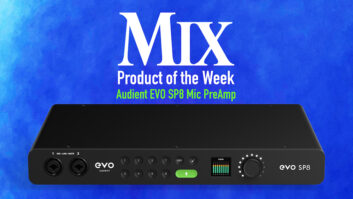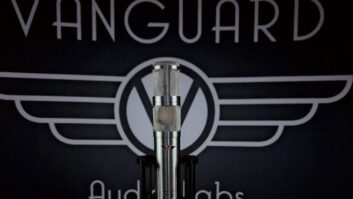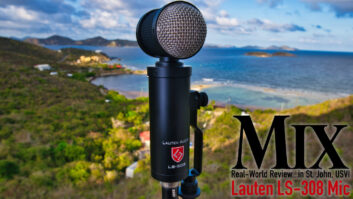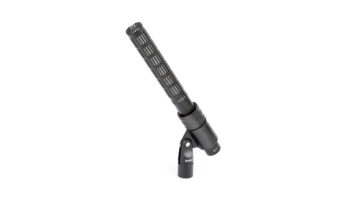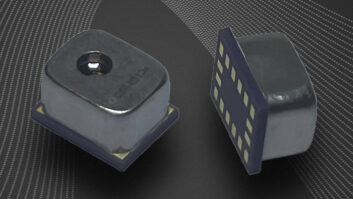
A home studio’s weak point often shows itself in the front end of the signal chain. For those looking for an affordable upgrade to their preamps, Audient just may have the answer.
The Audient ASP008 is an 8-channel mic pre with variable input impedance. Based on the preamp used in the company’s ASP8024 recording console, the ASP008 employs discrete, Class-A circuitry to achieve bandwidth extending out to 300 kHz and a noise spec of -127 dB. In addition to mic and line-level inputs on all channels, the ASP008 features two front panel ¼-inch, high-impedance instrument inputs. Optional expansion cards can be installed, enabling A/D conversion and digital audio output of up to 96 kHz/24-bit via ADAT optical or AES/EBU formats. The digital output may be retrofitted, though a return to the dealer will be necessary. My review unit had optional ADAT and AES outputs installed.
AT THE BACK
The ASP008’s rear panel features eight locking XLR mic inputs and DB25 connectors for eight analog balanced line I/Os. If there is an option card, the rear panel can also host a BNC jack for word sync input (up to 96 kHz), ADAT optical out, a DB9 connector for AES-S/PDIF out and two small pushbutton switches. These switches select AES or S/PDIF for the DB9 connector (AXI offers breakout cables at an additional cost) and set the unit to internal or external clock.
On the front are controls for each channel that include a three-position impedance selector for the mic input; switches for 48V phantom power, line, polarity reverse and highpass I/O; and knobs for gain (0 to 60 dB) and highpass frequency (25 to 250 Hz, 12 dB/octave). Channels 1 and 2 add an instrument switch and a 20dB pad. A pair of switches cycle through sample rate (44.1/48/88.2/96 kHz) and bit depth (16/20/24-bit).
IN MY EARS
For most of the review, the ASP008 was externally clocked at 44.1 kHz using a Lucid Audio GEN×6-96. For some sessions, sample rate was set to 96 kHz. As an aside, ASP008 runs rather hot, so leave an empty space above it when rackmounting to help dissipate heat.
I first used the ASP008 with a RØDE Tube Classic II microphone for drum overheads. Compared to the Focusrite ISA110 preamp I often use with the Classic II, the ASP008 had a slightly mellow timbre and was audible as slightly softened transients on the snare drum. Cymbals were bright and clear, and the ASP008 had no trouble handling the high output from the Classic II or from the (very high-output) Neumann M149.
IMPEDANCE CONTROL AND GAIN
The variable impedance switch produced interesting results. Increasing input impedance augmented output levels from most mics, including Shure SM57 and SM85, Audix D6, Neumann U67 and TLM 103, and an RCA 44BX. In most cases, the change in level was the only difference noted, with two exceptions being the 44BX and D6. When I recorded finger-picked guitar, the sonic differences were subtle. Five kilohms sounded just shy of muddy in the bottom octave of the guitar and 1.2 kilohms produced a bit more “air,” with a slight emphasis on the pick.
Like most ribbons, the 44BX has a low output and some preamps don’t have enough gain to achieve acceptable recording levels. The Audient fell in the middle range, where some instruments simply did not give the preamp the help it needed to produce strong enough levels. For instance, when recording the finger-picked guitar, the Audient was disappointing in that, even at the 5k-ohm setting where the output was the hottest, it still didn’t provide enough gain for sufficient recording levels to my DAW. On a strummed acoustic guitar, the 200-ohm setting produced an unusable low output, and at 1.2 kilohms, a bit higher. The 5k-ohm setting delivered the highest signal level for the same gain setting.
The ASP008 proved to be an excellent DI for bass and keyboards. Plugging in a Fender Jazz bass produced a round, solid bottom end, not much different from the DI on my Avalon AD2022 mic preamp, though the AD2022 was quieter. While recording a sampled piano, I noticed that the analog output added a very subtle coloration in the low mids that warmed the sound a bit; the optical out lacked this coloration.
SURVEY SAYS?
My main criticism of the ASP008 is one of ergonomics. I found it difficult to operate some of the controls due to their small size. Changing the impedance without moving the gain knob was difficult and I often bumped the filter knob when adjusting gain. Some of the indicators are difficult to read due to “LED crosstalk.” For example, the filter button LED leaks light into the signal indicator LED, making it barely possible to distinguish “signal present” status. Also, once DB25s are mated to the rear panel, they cover up the designations.
Despite this complaint, the ASP008 is a great tool, especially for anyone looking for an affordable front-end upgrade to their DAW. No doubt, it’s a cut above the mic pre’s built into most DAW interfaces, both in noise level and sonic accuracy. External sync worked flawlessly (kudos to Audient for including this crucial capability), and between the analog and optical outs, you should be able to interface it with just about anything. MSRPs: ASP008, $1,495; ASP008 w/ADAT output, $1,995; ASP008 w/AES and ADAT, $2,195; ADAT option card, $525; and AES option card, $725.
Audient, dist. in the U.S. by AXI, 877/440-2717, www.axidistribution.com.

